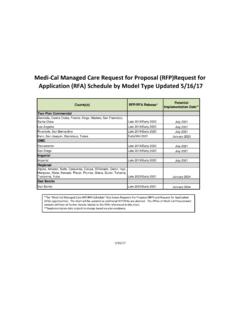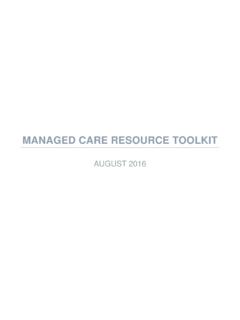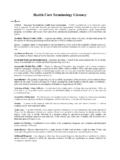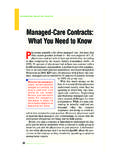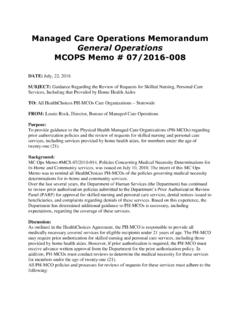Transcription of Health Systems Managed care: the US experience - …
1 Managed care : the US experienceNeelam K. Sekhri1 This article provides an overview of Managed Health care in the USA what has been achieved and what has not and some lessons for policy-makers in other parts of the world. Although the backlash by consumers and providersmakes the future of Managed care in the USA uncertain, the evidence shows that it has had a positive effect onstemming the rate of growth of Health care spending, without a negative effect on quality. More importantly, it hasspawned innovative technologies that are not dependent on the US market environment, but can be applied in publicand private Systems globally. Active purchasing tools that incorporate disease management programmes,performance measurement report cards, and alignment of incentives between purchasers and providers respond to keyissues facing Health care reform in many countries.
2 Selective adoption of these tools may be even more relevant insingle payer Systems than in the fragmented, voluntary US insurance market where they can be applied moresystematically with lower transaction costs and where their effects can be measured more : Managed care programmes; quality of Health care ; review literature; United page 841 le re sume en franc ais. En la pa gina 842 figura un resumen en espan Health care as it has developed in the USA,aand the current backlash against it, must be viewed inthe context of the traditional US Health care system of employer-based, indemnity insuranceand fee-for-service Health care conditioned bothproviders and patients expectations of unlimitedresources and unrestrained choice.
3 As Uwe Re-inhardt has aptly stated, it was the fairyland tale ofthe proverbial free lunch (1). Not surprisingly, theconstraints and controls imposed by Managed carehave resulted in outrage by doctors and their patients(and by doctorsthroughtheir patients).Although the response is predictable given thelimits on provider compensation and consumerexpectations of unrationed care , the methods usedby Managed care organizations have undoubtedlycontributed to the furor. That the US Administration isnow being asked by the public to step in and regulate the Health care market is an irony which HillaryClinton, who led the last ill-fated government attemptto reform the US Health care market, must findparticularly amusing.
4 Managed care in the USA findsitself under attack from all sides. Consumers complainvocally about denials of care ; and they and their lawyersclaim that Managed care organizations provide sub-standard quality of care for the sake of cutting costs,citing anecdotal evidence of negligence on the part ofhealth plans. As a result, several US states have passedlaws allowing Health plans to be sued for malpractice,and the team of lawyers that successfully brought thetobacco industry to its knees has now turned itsattention to Managed complain about unsustainable re-ductions in compensation, unfair labour practicesthat can dismiss physicians if they provide care that istoo expensive in the view of the Health plan, andunethical intrusion by Health plans into the practice ofmedicine.
5 Physicians are ready to unionize and theAmerican Medical Association, in an unprecedentedmove, supports this. Many US states have passed any willing provider laws requiring a Health plan tocontract with any and all physicians who are willing toaccept its contract. This runs counter to thefundamental Managed care tenet of selective con-tracting and protects the system s excess supply ofphysicians, particularly Managed care industry might be able towithstand these criticisms if it were actually makinghuge profits, a charge levelled by providers and thepublic. In fact, although Managed care enrolment hascontinued to grow, the net income of most managedcare organizations has plummeted.
6 In 1997, forexample, they reported collective losses of almostUS$ 1 billion (2). As a result, Health plans have postedsignificant employer premium increases for the thirdyear in a row, and now find their previous allies, thefunders of care , frustrated and antagonistic (3, 4).Despite provider reactions, horror stories in themedia, and government rhetoric, neither US employ-ers nor government funders are willing to return todouble-digit annual percentage increases in Health carecosts (3). Medicare, the largest government funder,which provides coverage to those aged over 65 years, isrequired by the Balanced Budget Act of 1997 tosignificantly reduce spending and extend the life of theMedicare trust fund.
7 Employers, still protected by the1 Founding Partner, Healthcare Redesign International,875-A Island Drive #381, Alameda, CA 94502, USA(email: otherwise specified, the terms Health plan and managedcare organization are used interchangeably in this article to refer toan entity providing or arranging for coverage of Health services neededby members of a plan for a fixed, prepaid Theme Health Systems830#World Health Organization 2000 Bulletin of the World Health Organization, 2000,78(6)booming US economy, have been able to absorb risinghealth care premiums so far, but foresee a day fastapproaching when increases in premiums will bepassed down to employees or will force employers tostop providing Health care coverage (5).)
8 This can onlylead to a further swelling of the ranks of the 44 millionuninsured people in the USA (6).What is the truth behind the complaints aboutmanaged care ? What is the evidence that US healthcare quality is suffering due to an overemphasis oncost containment? This article provides an overviewof the state of Managed care in the USA today, what ithas achieved and what it has not; and some lessonsfor policy-makers in the USA and overview of the US Health caresystemThe US Health care system is unique among wealthyindustrialized countries in the extent of its reliance onthe private sector for the financing, purchasing anddelivery of Health care services. Public expenditures through federal, state and local governments total 45% (Fig.)
9 1) of overall Health spending,primarily for purchasing Health services for specificpopulations ( the elderly, disabled, veterans, andthe poor). The large majority of US residents receiveshealth insurance benefits through their employersand accesses services delivered by the private receive a significant tax subsidy forproviding private insurance to employees and theirfamilies, and employees often share in the cost ofbenefits. However, almost 44 million people are notcovered by any continuous public or private healthinsurance scheme and have limited access to privatemedical resources. They receive care through publiclyoperated clinics and hospitals or pay out of pocket forservices to private providers (7).
10 At , the USA devotes a higher percentageof its gross domestic product (GDP) to Health care thanany other country. This percentage has remainedessentially flat since 1992 (8), which is attributable tothe strong US economy, the Balanced Budget Act of1997, and the dramatic shift away from indemnityinsurance into Managed care plans. Although annual percapita Health expenditures in 1998 of US$ 4094 (9, 10)were still well above those of other OECD countries,they are growing at a much slower rate than in the 2 provides an overview of the US healthcare system: the funders, purchasers and providers ofcare are generally distinct entities. Some managedcare organizations, however, serve as both purcha-sers (pooling the risk) and providers of care ; 89% ofemployees are now enrolled in plans with some formof Managed care (11).












